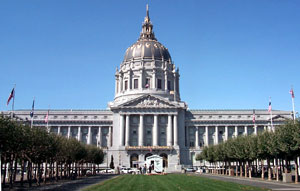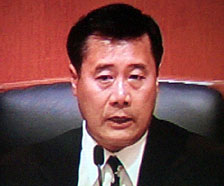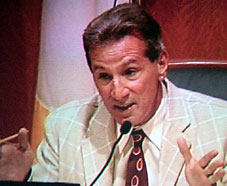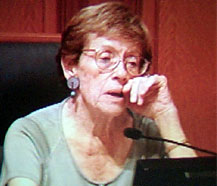Remarks at the
San Francisco Board of Supervisors' Labor and Finance Committee --
Members Leland Yee, Tom Ammiano & Sue Bierman -- 9/20/2000
WRITE to the Committee Members! They are still working on the Fort Funston issue and need to hear from people:
|
|
|
|
Write from the Heart! Does a visit to Fort Funston — wandering the paths, enjoying the vistas, greeting other visitors — brighten your day and lift your spirits? If so, please convey the personal sense of inner peace, relaxation, renewal and community that the park and your fellow park users give you — your individual relationship with Fort Funston — in your letters to Park Service and City officials. Also explain any ways in which the most-recent closures, including the related fences and tensions, diminish your daily visit. Share from the heart -- from within that special spot in which you hold Fondness for the Fort.

Here are some of the speeches from the
Hearing on Fort
Funston Closures
before the Labor & Finance Committee of the San Francisco Board of Supervisors,
City Hall, September 20, 2000
Committee Members: Supervisor Leland Yee, PhD., Chair; Tom Ammiano; Sue Bierman.
We're here to consider the National Park Service's closure of open space at Fort Funston which has resulted in a reduction in land available for dog walking and other recreational resources by residents.
Supervisor Leland Yee:
Thank you very much... before I open this up to comments, there are a list of speakers I want to call. Before that, let me make some general comments.
The Fort Funston area is an area that I have gone to quite a bit of times, particularly when my children were a lot younger. I think it is a recreational facility, but it is also a place where many young children could go and explore and understand more clearly not only nature but the relationship between individuals and nature.
There is an educational facility there that Supervisor Ammiano and I, when we were on the Board of Education, were particularly proud of and very, very supportive, so this is an area that is of great concern to all of us -- that we continue to allow this place to be open to the general public.
I think the second area of interest for the City and County of San Francisco is that the City and County of San Francisco dedicated, transferred some of the land, the Fort Funston area, to the National Park Service ... So, on one hand, while we have turned that over, I'm sure that no one would say that we no longer care about its particular use. And so, to that extent, I think it's extremnelty important that this body and the entire Board of Supervisors, takes up attention to how and exactly what is beiug done to the Fort Funston area.
My immediate concern at this particular time is to find out exactly what is going on relative to Fort Funston. I did receive a briefing from the Golden Gate National Recreation Area officials; unfortunately, because this item has been remanded back from the courts to them for deliberation, they felt that it was inappropriate for them to come before this particular body and make their presentation, but we did, in fact, receive a briefing from those officials, and we will take that information and we will enter that into the record. However, that does not mean that they are absolutely not going to have any involvement in this particular proceeding. I think that they are monitoring this particular proceeding quite intensively, because they clearly do not want the City and County of San Francisco to be at odds with their particular position, so to that extent, I think that there is a welcome hand of cooperation. We will be speaking further with the City Attorney in terms of our jurisdiction over this particular issue.
So, with that, let me go ahead and call the list of speakers who have been particularly involved with this particular issue, and we will then, after this presentation, open it up for comments. The first such speaker, and, unfortunately, because of our time constraint, and there are so many individuals here who would like to make public comments, we limit the public comments to two minutes, and we will go from there.
The first speaker is Lydia Boesch.
 Lydia
Boesch:
Lydia
Boesch:
It's my understanding I have two minutes -- correct? So, I, my three minute speech, I'll talk fast, and when I'm done..
[Supervisor Yee]: Yes, actually, if you have anything in writing, please submit that to us and if you can paraphrase whatever you have, that will help us out tremendously. Thank you very much.
[Supervisor Ammiano]: Two minutes is one hour in dog years!
I'll talk fast. I am an attorney and I have been representing the plaintiffs in the federal litigation. I want to thank you so much for having this hearing. We are here to tell you that the City does have a direct interest in this closure, and we want to tell you our story and ask for your help.
First, the history of Fort Funston. In March 1960, the federal government announced its plans to dispose of Fort Funston, unless the City could come in right away and make plans to buy it. The City responded quickly. In April 1960, the Rec and Park Commission passed a resolution to acquire Fort Funston for "recreation and park purposes". In May 1960, the Planning Commission followed suit, and passed a resolution to acquire the park, for "open recreation and park use". Then, the Board of Supervisors passed a resolution, to acquire Fort Funston for "public recreational and park purposes". Fort Funston was finally opened to the City as a city park in October of 1961.
In the relevant historical documents, the term "park purposes" and "recreational purposes" were used synononymously and interchangeably. What these terms describe are various activities on the land at Fort Funston, and included hiking, cycling, sand dune recreation, day camps, bridal paths... and even a golf course.
In 1972, Congress created GGNRA, and it was "to provide needed recreational open space, necessary to urban environment and planning". The House of Representatives said the new urban recreation area would "concentrate on serving the outdoor recreation needs of the Bay Area". San Franciscans were concerned right away about giving up control of their parks. The Planning Department, the Recreation Department -- Park and Rec -- and the Board of Supervisors all passed resolutions wanting this park to be maintained by the city, under city control, even though the federal government had got it.
We have a deed; when we gave the land away, we -- in the deed, there is a reverter, which means the City can take the park back. We also entered into an agreement where the City was supposed to be involved in the operations of Fort Funston. We believe the covenant has been violated, and we would like you to do whatever you can to help us go back to its original intent.
Nathan Winograd:
Nathan Winograd, on behalf of the 91,249 members of the San Francisco SPCA.
For some twenty years, the recreation needs of San Franciscans have by and large been honored, wildlife and recreation co-existing peacefully, han gliding, exploring, hiking and dog walking have thrived side by side with the flora and fauna.
In the 1990s, that all changed. With the arrival of new management Park Service staff to handle the transfer of the Presidio, historical ties to San Francisco were broken. In October of 1991, the National Park Service illegally closed approximately seven acres of Fort Funston, to implement native plant habitats. This closure was conducted without an environmental impact analysis, without proper project approval, and without public hearings, in violation of their own regulations and federal law.
Beginning in 1992, as public concern about the closures was increasing, the National Park Service held a meeting with the public, and promised that the closure would be temporary, limited to one year. That promise would not be honored. Instead, the National Park Service expanded the project by an additional three acres, one year later.
In 1994, an additional closure of 15 acres was proposed, without analysis or public hearings, and the National Park Service was not shy about the land grab. The project report confirmed, the project is ... "expanding into areas beyond our previous agreed-to perimeter; new areas are now within our grasp."
The National Park Service would not stop there. In 1995, they not only closed the 15 acres, but added another 10 : 25 acres in all, and again, they promised no more fences. That promise again would not be honored.
In 1999, the National Park Service approved the current 10 acre, now 12 acre, closure. In an e-mail, they admit that the project had not had a proper review... instead, the project seems to have been buried. It is no surprise that a federal judge found, "An intent on the Park Service to railroad through the closure, to maintain secrecy, to unleash the fencing with lightning speed, and to establish a fait accompli. Thank you.
Linda Shore:
Good morning, supervisors, members of the public, thank you for giving me the opportunity to speak. My name is Linda Shore, I'm a physicist at the Exploratorium, I'm also a regular walker at Fort Funston, I'm a native San Franciscan and a lifelong resident of the Sunset. Let me tell you briefly why I became active in the fight to save the open spaces of Fort Funston for myself, my family, and for the citizens of San Francisco.
I believed the Park Service all along when they told me that in 1991, in 1995, the closures were to protect the bank swallow. I also believed the Park Service when, in '95, they said the closures had come to an end. But in 1999, when another 10 acres of the most popular parts of Fort Funston were closed, I decided to investigate the science behind their decisions.
Because my time is very limited here, I urge you to read very carefully the written materials that the dog walkers will submit to the National Park Service as a formal response. It contains descriptions of the bad science behind their proposals, and it also provides detailed testimony of various experts, and the results of literature review, but let me very quickly highlight just a few examples of some of the gross scientific errors you'll find.
Claim: The bank swallows require a native plant habitat to supply the colony with food.
Fact: Bank swallows are common throughout North America, have been studied extensively, and no binding associations between bank swallows and any particular species of plants, native or not, has ever been found.
Claim: The bank swallows are disturbed by recreation occurring near their nesting sites.
Fact: Researchers have found bank swallows to be remarkably tolerant towards human disturbances. Colonies are found within active rock quarries, along busy interstate highways, and on the banks of rivers and lakes used for recreational boating.
Claim: The cliffs at Fort Funston are a fragile geological resource that can be damaged by human recreation on the bluffs.
Fact: Geologists who have conducted extensive research at Fort Funston, two of them, in fact, stated independently that human-induced damage to the geology of Fort Funston is negligible. As one of the experts stated to me, "the amount of material lost in cliff-retreat and landsliding dwarves any impact imaginable from people" walking on the cliffs.
In closing, supervisors, there is bad science in the proposal, and clearly the Park Service is trying to justify these closures in order to transform a popular recreation area into a native plant restoration area. And that, simply, in a city that's as heavily populated as this is, is just not advisable.
Thank you very much for your time.
Alberta Romanini:
Mr. Chairman and members of the Committee. Thank you for giving me this opportunity to speak. My name is Alberta Romanini, and I have been a fan of Fort Funston for about 40 years.
As a troubled teenager, I found solace and serenity there. As a hardworking adult, with adult worries and problems, I found peace, companionship, and respite from life=s burdens.
In my teenage years, Ft. Funston was closed to the public. It had mountains of wind-whipped sand dunes and seas of crisp, fragrant ice plant.
Did you know that on very hot days like this ice plant smells like grapes? Well, it does!
Even in those days the Fort had many devotees - some with dogs, some without. They parked where they could and hiked in. I don=t remember ever feeling unsafe there. Its regular users were a presence during the entire day -- every day -- and crime didn't have much of a chance against hundreds of vigilant eyes.
I spent many hours at the cliffs' edge, looking out over the magnificent sea and drinking in its salty spray. I marveled at the pelicans spiraling into the water and watched as playful terns swooped and called plaintively. I gazed in awe at colorful hang-gliders dipping and rising and floating like gigantic butterflies in the wind. I saw God=s face in beautiful winter sunsets.
After GGNRA took over, Ft. Funston was opened to the public. New users happily mingled with the "old timers." The Fort became more accessible to people in wheelchairs and families with young children in strollers. To seniors with canes and tourists walking arm-in-arm. To joggers, cyclists, and College film students making the next award-winning documentary. The Fort was an idyllic oasis. There was room for everybody.
About ten or twelve years ago, change came to the Fort. Old trees were severely thinned or cruelly chopped down and fences sprouted up here and there. One day, Park Rangers, whom most of us had never seen before, began issuing written warnings to park users who where not walking on the paths or whose dogs were running off leash!
Concerned citizens quickly mobilized. We appealed to elected officials, to the SPCA, to the City=s animal control board, and to the media. We spoke passionately at hastily called meetings and public hearings, and we PREVAILED! Or so we thought.
In the days and weeks subsequent to its unexpected set-back, GGNRA made tongue-in-cheek promises under the guise of conciliation and cooperation. Looking back at videotapes and meeting notes, I believe that GGNRA= s employees chose their words with calculation and an intention to deceive.
Recent findings in Federal court revealed what had previously only been suspected:
While deliberately withholding information and denying input from the Fort=s frequent users, GGNRA regularly met and consulted with selected groups and individuals in order to circumvent enabling legislation and renege on signed and oral agreements. Strong words? No. Documented facts.
If this arrogant agency is not brought to heel, there will come a time when public access to Fort Funston will consist of watered-down guided tours.
No bike riding, hiking, or jogging. No children and dogs frolicking up and down dunes of sand and ice plant. No families picnicking under its trees. No paved paths for our seniors and disabled. No standing at the edge of the cliff with arms widespread and face to the wind.
I foresee a time when GGNRA will propose the erection of new buildings and urge people indoors to learn about nature from lectures, exhibits, and brochures instead of allowing continued, unfettered access to the outdoors, where the best lessons are taught by sun, wind, and sea.
I see a time when Ft. Funston will become a packaged nature "experience" for tourists and groups of school children on carefully monitored field trips instead of remaining the wild, wonderful place it has always been for all people to visit, care for, and enjoy.
Please. Read our letters. Listen to our words. Feel the passion we have for this place. Share our outrage over a betrayal of public trust.
All of us have been betrayed by an impersonal, unfeeling agency, which in its self-righteousness does not appear to be concerned about violating legislation, internal policies, and agreements made in good faith with the citizens of this City and the users of this park.
Come to Fort Funston and smell the grapes!
Thank you.
Comments by Supervisor
Leland Yee
at Conclusion of Hearing on Fort Funston Closures,
September 20, 2000:
First off, let me just say thank you to Lydia Boesch for sending me the material that sort of piqued my interest, and I have to be honest with you, when I received the material, it was so thick that I just kind of set it aside. But then I received another interesting letter from a friend of mine, who has taken a position on this particular issue, and then I received another thick packet from the Shepards, and I also set that aside. And then, as I set that aside, I think some of the information through osmosis must have gotten through, and it was articulated today, and I need to just express that.
People talk about the dogs, talk about the ecology and so on, but what really struck me in the letters that I've received and some of the testimony that I've heard today, is the mental health aspect of Fort Funston. The comments that I've heard about how this experience enriches their lives, how it helps them with not only their mental health, but it affects their physical health, is something that weighed very heavily on me. In an urban center, in the hustle and bustle of some transportation problems, the economy, and family issues, and so on, there is not a whole lot of place that maybe you can find some peace and tranquility, and when you have a place like Fort Funston, I think we need to look at ways to preserve that and leave it not only for ourselves but for future generations.
This issue is a rather troubling issue for me, as one member on the Board of Supervisors, we continually battle this notion of privatization, where more and more public interests and public assets are turned over to private companies, so that they can do with it how they want, and they leave the crumbs for the public. This somehow, this particular issue, the closing of certain areas.... concerns me, too. This is not a private entity; oddly enough, it's a public entity that is doing this. I think it's extremely important that we somehow preserve this piece of area for future generations, and not allow, somehow, an element to be introduced in there to then ... affect the environment so that we will not have Fort Funston anymore. We need to also look very carefully that we are not jumping the gun in closing off an area unnecessarily. I think that it is those kinds of concerns that led me to the following conclusion, and if the City Attorney can take note of this, that:
It is extremely important that the City and County of San Francisco maintain whatever control we have on Fort Funston. It is our land, we gave it to the federal government not to allow them to do whatever they want, but to keep that covenant of whatever the people wanted, and I believe it is for us to use and for us to then recreate in. To that extent, with the documents that we have been given so far, and with your good office, I would ask that you look at exactly the terms and conditions of that conveyance and, to the extent that we somehow have control over it, that we exercise that control. And then also, with regards to the enabling legislation, to understand exactly the whole context of that piece of legislation, as to what we can, in fact, do with Fort Funston.
I think the second area that I want you to look into is that if, in fact, the basis for the closure is to maintain the environment and ecology, I think that I would ask that you look at whether or not that premise is a sufficient premise; whether or not it is an adequate premise, whether or not the basis for this closure is sufficient, given the arguments and given the data that have been presented, and to also look at many of the comments, and also the research that's been done thus far, to then argue that the basis was not established....
And then, finally, I think as the president [of the Board of Supervisors, Tom Ammiano] asked, are there other alternatives to just simply this closure. So, if you could prepare this information to us, hopefully by, I hope, the middle of October, because, my understanding is that the, out of the settlement in the court case, the GGNRA will in fact be holding some additional public comments in October, and what I'd like to do is to see how that set of public comments will happen, and then at that point we should re-inject ourselves into this to determine whether or not there's sufficient argument that the National Park Service has provided for this.
[Best effort to transcribe from audiotape; some unclear sections]
Press Release:
Supervisor
Leland Yee Calls For a Hearing
to Determine the Future of Fort Funston.
For Immediate Release
Contact: Monica Lim
September 15, 2000
Phone: (415) 554-7752
WHEN:
Wednesday, September 20, 2000
TIME: 11:30 a.m. SHARP
Time Certain Item during the Finance and Labor Committee Meeting
WHERE: City Hall, Room 263
Supervisor Leland Yee, Chair of the Finance and Labor Committee, called for a hearing to discuss the proposed closure of 12 acres of recreation space at Fort Funston. Fort Funston has long been a popular spot for residents from all over the city to play with their children, walk their dogs, and simply enjoy the picturesque surroundings. Controversy erupted after the National Park Service proposed permanent closure of 12 acres of Fort Funston to public access. After weeks of public outcry, Supervisor Yee initiated a hearing to discuss whether or not the National Park Service, represented locally by the Golden Gate National Recreation Area, violated its agreement with the City of San Francisco to keep Fort Funston an "open space necessary to urban environment and planning."
"Open recreation space at Fort Funston is a valuable resource for the San Francisco community," stated Supervisor Yee. Since 1991, the National Park Service closed over forty acres, approximately 20%, of Fort Funston against the wishes of local residents. The public has asked Supervisor Yee to act immediately to protect important community rights by rejecting the National Park Service’s proposed closure of valued recreation space at Fort Funston. "People all over the City and as far as Santa Rosa have contacted me to let me know that they are outraged over the closure," declared Yee, "this is very important to the people of the Bay Area."
The GGNRA claims that dog walkers, the primary users of the facilities are contributing to erosion and the decline of the bank swallows. The GGNRA has come forward with plans to develop a wildlife habitat and grow native plants. Opponents counter that earlier closures have not helped the population of the bank swallows. They also claim that promises from the GGNRA to reopen formerly closed lands have not been kept. Activists claim that disability access has been dramatically reduced due to previous closures and that the GGNRA has made no effort to expand disabled access. Supervisor Yee will preside over representatives from the GGNRA, SPCA, Independent Living Resource Center, Fort Funston Dog Walkers, and concerned neighbors from all over the city are expected to give presentations.
The hearing will take place
on Wednesday, September 20, 2000 at 11:30 a.m. during the Finance and Labor
committee meeting in room 263 at City Hall.
To
First Section of Fort Funston Forum


